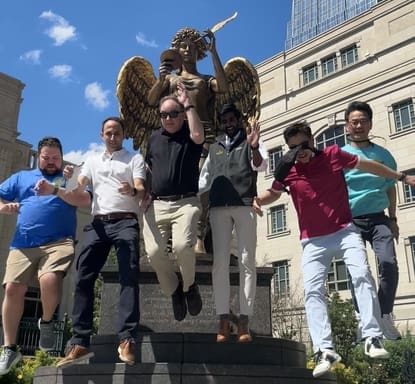Think of your favorite fantasy film or book featuring a powerful and cohesive team. Maybe you like Harry, Ron, and Hermoine. Or, Han, Leia, and Luke. Or, Aragorn, Legolas, and Gimli. In every one of those stories, our beloved adventurers transform from being individual characters to being members of a powerful team. How?
Usually, someone gathers the adventurers together in some sort of strange meeting and then sends them on a quest. Soon after, our adventures are forced to work together. They squabble and clash. Egos flare-up. After a while, though, they begin finding a new balance. They start liking each other and respecting the genuine talents of their team. Finding equilibrium, then, allows our adventurers to become the epic heroes we love and adore. Before we know it, our heroes have slain the bad guy, and the story is over. Our heroes either disband or move on to the next adventure.
In the real world, successful teams in organizations follow the same team development steps. You may have heard of them before (we’ll get into that). If you know these steps, you will have a crystal ball. You will attain the power to foresee the many trials and significant victories all teams will experience.
Further, it will let you connect the logic of story and narrative in your team building journey. When you call a team together to conquer a unique problem, you are just the suit-wearing and 21st-century version of Gandalf assembling his fellowships of heroes.
Five Stages of the Team Building Process
Team development is the process of turning talented individuals into a high performing unit. American Psychologist Bruce Tuckman studied teams and observed that all went through five distinct team development stages. He called these stages: forming, storming, norming, performing, and adjourning.
Every team goes through these stages! By knowing them, you will be able to predict your team’s future course, and you will have a good idea for how to plan for it.
Forming
Every adventure starts somewhere. Gandalf will arrive with the dwarves, or Harry and the gang will get sorted into the same house. The opening stage of our journey is called the forming stage.
At this time, team members will be cordial and polite. They might not know each other yet, so they are putting on their best polished and sociable face. They might even feel a little awkward! For some great icebreakers for the forming stage, check out our top team building games.
Everyone is new at this time, so the leader takes a more active role. During the forming stage, team leaders usually introduce team members, discuss ground rules, and outline the purpose and goals of the team.
Storming
As time moves on, the adventurers begin losing patience with each other. This moment of tension is called the storming stage.
Remember when all the elves, dwarves, and humans are arguing about who shall take the Ring to Mordor? The elves dislike the dwarves. The dwarves dislike the elves. And the humans? They just want to use the Ring as a weapon. All three groups begin squabbling with each other, hurling insults and brandishing axes.
In the real world, this storming stage happens when team members begin to speak up for themselves. Differences in needs, working styles, and personalities become apparent. This new awareness naturally leads to conflict. But this conflict is good because it teaches your team to work together.
You should note, however, that some teams leave the storming stage before working through all their problems. These problems can and often do arise later on. For this reason, team leaders usually take a more proactive role in conflict resolution during this time, instead of leaving things to chance.
Finally, due to the tense nature of the storming stage, team productivity tends to decrease at this time. However, this slowdown is only temporary.
Norming
Eventually, our adventurers learn to work together. In the last example, the fight finally ended when Frodo spoke up and expressed his willingness to take the Ring. Gandalf assents. Then Aragorn, Legolas, and Gimli volunteer to help Frodo, followed by Boromir and the other three hobbits. Each person knew their unique role and willingly ventured off into great danger.
In the real world, the norming stage is the moment where the team members reach an equilibrium and begin to appreciate one another’s unique contributions. Cooperation increases at this time, and so does productivity. A great way to keep your team in alignment is to continue to value connection through games and activities.
Performing
Eventually, your team of adventurers will become very good at killing orcs.
This stage is called the performing stage. Teams at this stage will start doing their best work. They will know how to collaborate, maximize their strengths, and minimize their weaknesses. They will solve problems with genius cunning. And they will exceed many of their previous expectations.
At this stage, the team will stay primarily focused on problem-solving and meeting goals. Though problems will still arise, teams during the performing stage will know how to address their issues and can use conflict as a tool for improvement.
Adjourning
All adventures must end. There and back again. In the adjourning stage, the team has completed its primary tasks. The primary emphasis falls now upon finishing final projects, signing necessary paperwork, and recording the team’s results. After this stage, the team usually splits up.
Some people call this stage the “mourning” stage because it can
Leadership Activities for Each of the Five Stages
Forming
In the forming stage, the leader has a substantial task. You are Gandalf introducing Bilbo and the dwarves. The team hasn’t formed yet, and the Wizard must force their meeting.
As a leader in the forming stage, you need to take a proactive stance. Use this opportunity to introduce everyone, establish ground rules, and communicate team goals.
Try turning this into a fun experience that makes everyone comfortable. Have a nice meal, use some fanfare to announce your team members, and inform them that they are part of something special. The forming stage is also an excellent time to do a team building activity. If you are looking for ideas, you browse through our top team building games.
Storming
As you know, your adventurers are going to squabble in the storming stage. Who will take the Ring?
The storming stage puts the leader in a unique position to get the most out of conflict. Try to use this time to settle disputes and establish best practices for resolving future conflicts. Also, try encouraging team members to express their individual needs and perspectives. When team members speak out, they get the most out of this stage.
As a leader, you have the opportunity to be a role model during the storming process. Keep cool. Let your team know that conflict is a natural and expected component of the team development process. Then, model peaceful dispute resolution and use it to resolve significant conflicts. This way, you can prevent any severe resentments from continuing after the storming stage has completed.
Norming
At this stage, a leader should step back and let the team members take responsibility. Consider the vast stretches of the journey where Gandalf is not present.
So what you be doing as a leader during the norming stage? Consider scheduling a team building event. A memorable team building experience will allow your team members to practice all the skills they learned in the storming stage. Let your team run free and see what they can accomplish.
Performing
Now you have a dream team. At this point, you should be delegating as many tasks as possible. Your team won’t need much guidance, and you can take a light approach.
For you, the performing stage might be an excellent time to start recording a personal inventory of everything your team has gone through. What kind of best practices and norms have they formed? Identify the way they’ve changed in the areas of communication, conflict resolution, and decision making.
Adjourning
Your adventurers have finished their journey. There were fun moments, challenges, and ample opportunities to bond and level up. As a leader, you should use this final stage to formally recognize your team’s accomplishments. Throw a dinner, give awards, or deliver a rousing speech.
This final adjourning stage is also a great time to help team members emotionally process their team development. Try discussing their feelings, thoughts, and visions for the future. If you can, help give the idea of where they might like to go next.
Start Team Building Today
Now you have a better idea for the stages of team development: norming, storming, forming, performing, and adjourning. By knowing them, you have a better idea for how you might structure a team building adventure in your future. You have a sense of when and where problems will arise and when the payoffs will be the most gratifying. Most importantly, you see that team building is not a static goal, but a dynamic process that requires a mindful, even wizardly managerial approach.
By now, you probably already see when and where you will need to implement some team building activities. During the forming stage, you will benefit from a team building activity. This activity will help you make introductions and build an initial sense of cohesive purpose.
As your team progresses to the norming stage, they will probably require a more vigorous team building activity. A team building activity here will give your team a chance to practice their hardwon skills, gained in the trials and tribulations of the intense storming stage. A fun event at this time will help alleviate tension and give your team a chance to reconnect.
We would be remiss if we didn’t mention our CityHunt Scavenger Hunts as a great way to build your team. CityHunt has created dozens of customized scavenger hunts through a broad spectrum of U.S. cities. Our designs come from research at the University of Pennsylvania and Stanford, which we use to get the most substantial and reliable outcome for your team. We invite you to fill out our contact form. Once you do, you will receive a call from us as soon as possible. We’ll talk about your team and share research relevant to you. Then we’ll suggest which scavenger hunts we think will benefit your team most at this moment in their journey.
Remember, team development is a process. But knowing the process, with its challenges and massive rewards, will put you in a better place to lead.
Onto the next adventure.




